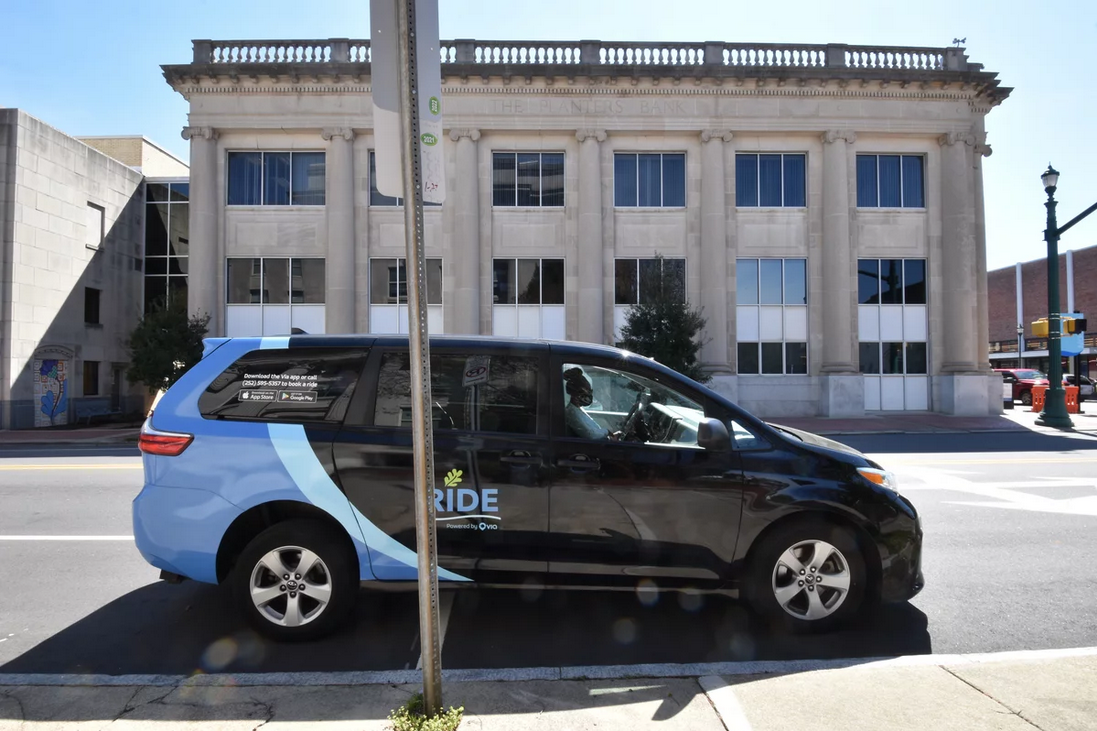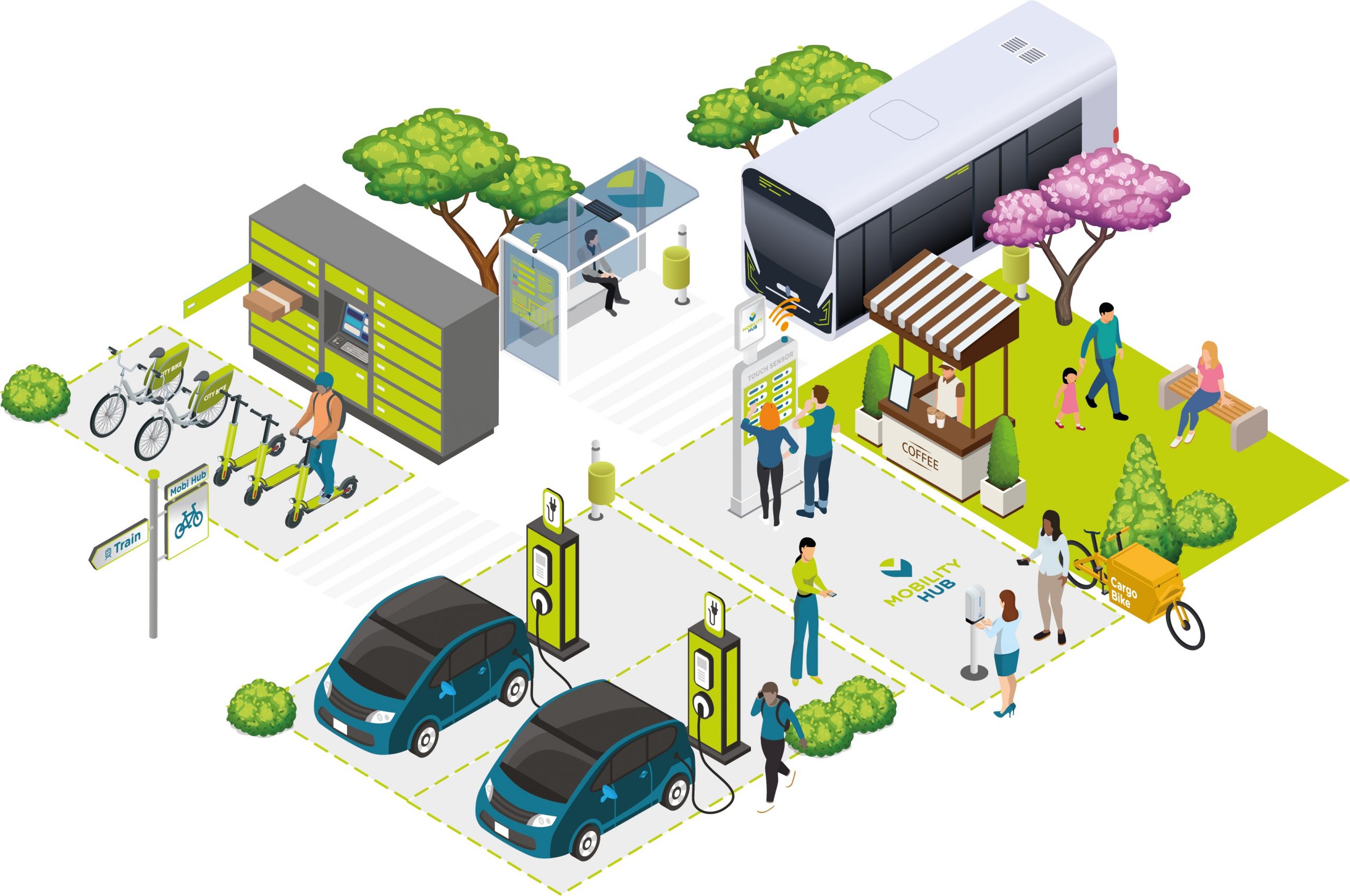New Transportation Technology in North Carolina
Led by NCDOT’s Integrated Mobility Division, North Carolina is promoting the use of new transportation technology to achieve three goals: increase access, enhance quality of life, and ensure safety. The overall vision is for North Carolinians to have equal opportunity to get anywhere in the state, with or without a car.

Mobile technology (devices like smartphones and the wireless networks that connect them) is disrupting established transportation systems and practices. Examples of services enabled by mobile technology and real-time location data include ride-hailing and car sharing; bikes, e-scooters, and other micromobility options; and fixed and flexible route transit services (for example, microtransit). Shared electric bikes (e-bikes) are a growing trend nationally. Collectively, these services are referred to as new mobility. A related concept, Mobility-as-a-Service (MaaS), integrates different travel options into a single mobility app. New mobility is an emerging concept mostly confined to cities and metropolitan regions, driven largely by private companies like Uber and Lyft. Potential benefits include, among others, reduced car dependency, improved air quality, and increased mobility for people who lack access to private vehicles (for example, in rural areas with limited transit service).
The Challenge
New mobility services pose both opportunities and challenges for North Carolina communities. The biggest opportunity is to provide convenient, affordable options for those lacking access to automobiles or who choose not to drive. Additional benefits in urban areas include reduced traffic congestion and support for more walkable, bikeable communities. While rural applications are presently limited, services such as on-demand microtransit can improve mobility in areas with limited public transit. In 2022, the U.S. Department of Transportation announced a $10.4 million award to NCDOT to provide on-demand transit services in 11 rural communities. Mobility hubs – connecting services such as transit, rideshare, and bikeshare – can enable people to get where they want to go without using a car.
Potential Responses
Short-Term
- Address transportation technology/new mobility services in local and regional plans
- Establish policies to maximize benefits and address challenges such as barriers to access by underserved populations (low-income, elderly, persons with disabilities, etc.)
- Create public-private partnerships to connect different mobility options
- Initiate pilot projects (e.g., mobility hubs in urban areas; on-demand microtransit in rural areas with limited transit service)
Medium-Term
- Scale up pilot projects and partnerships
- Ensure equitable access for underserved populations as new mobility services increase in urban and rural areas
- Monitor national and international trends and best practices to determine how they might be applied in different contexts in North Carolina
- Initiate new pilot projects and programs (e.g., regional MaaS apps)
Long-Term
- Coordinate new mobility services and applications across the state to achieve the vision of equal opportunity for people to access places they want to go, with or without a car
- Monitor the development and deployment of new technologies (autonomous vehicles, urban air mobility, etc.) and their implications for North Carolina
Key Stats
- In the US, bikeshare programs have existed at scale since 2008. Shared e-scooters launched in late 2017 and quickly grew to nearly half of total shared micromobility trips (Urbanism Next Center 2020).
- 136 million trips were taken on bike and scooter share systems in 2019, 65 million in 2020 (the pandemic lockdown year), and 112 million in 2021. They averaged 11 minutes in duration and 1.2 miles in length in 2021 (NACTO 2022).
- More than one million North Carolinians live in a household without a car or have other barriers that limit their ability to use a vehicle regularly (Brumfield 2022). New transportation technology can provide alternatives to private automobile use and create opportunities such as first/last mile access to transit stops.
- A survey of North Carolina residents found that 76% of respondents travel by car today. However, the importance placed on traveling by car decreases by 51% in the future, when 25% of respondents indicate a desire to travel by car, 24% by rail (compared to 0% who do so today), 16% by walking (2% today), 13% by bus (2% today), and 7% by bicycle (2% today) (NCDOT 2021).
 Wilson RIDE (Credit: NPR)
Wilson RIDE (Credit: NPR)
Example: City of Wilson
Wilson launched RIDE, an on-demand microtransit service, in 2020 as a pilot during the pandemic. A relatively small community of about 48,000 residents, Wilson previously ran a fixed-route bus system that served about 40% of the city’s area and averaged about 1,450 rides a week before the pandemic. Via, a leading private provider of mobility services, operates RIDE. Its premise is simple: passengers can request van rides in real-time to and from anywhere within the boundaries of Wilson at a similar cost to riding a bus (Shared-Use Mobility Center 2023). Customers can book rides using a smartphone app, an online portal, or a central dispatching phone. Ridership has steadily increased since RIDE was initiated in September 2020, reaching a high of 4,700 (more than triple the ridership on the fixed-route bus system it replaced) in April 2023.
Click here to complete our survey about North Carolina drivers of change!
References
Brumfield, Ryan. Addressing Transportation Disparities by Embracing the Future of Mobility. Eno Center for Transportation (2022)
Crozier, Andrew and Lisa Nisenson. Planning and Zoning for Mobility Hubs (2022). American Planning Association, Zoning Practice (2022, Issue No. 3)
National Association of City Transportation Officials (NACTO). Half a Billion Trips on Shared Micromobility Since 2010 (2022)
North Carolina Department of Transportation (NCDOT). NC Moves 2050 Plan (2021)
Shared-Use Mobility Center. Take a RIDE with Me: Highlighting the Adoption of Citywide Microtransit in Wilson, NC (2023)
Urbanism Next Center (2020). Micromobility Fact Sheet.


